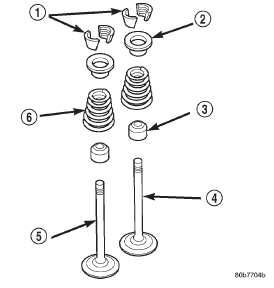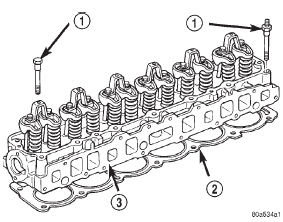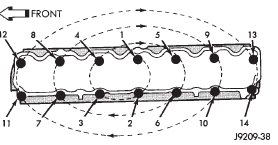Jeep Cherokee (XJ): Valve springs and oil seals. Cylinder head. Valves and valve springs
This procedure can be done with the engine cylinder
head installed on the block. REMOVAL Inspect the valve stems, especially the grooves. An
Arkansas smooth stone should be used to remove
nicks and high spots.
Each valve spring is held in place by a retainer
and a set of conical valve locks. The locks can be
removed only by compressing the valve spring.
(1) Remove the engine cylinder head cover.
(2) Remove cap screws, bridge and pivot assemblies
and rocker arms for access to each valve spring
to be removed.
(3) Remove push rods. Retain the push rods,
bridges, pivots and rocker arms in the same
order and position as removed.
(4) Inspect the springs and retainer for cracks and
possible signs of weakening.
(5) Remove the spark plug(s) adjacent to the cylinder(
s) below the valve springs to be removed.
(6) Connect an air hose to the adapter and apply
air pressure slowly. Maintain at least 621 kPa (90
psi) of air pressure in the cylinder to hold the valves
against their seats. For vehicles equipped with an air
conditioner, use a flexible air adaptor when servicing
the No.1 cylinder.
(7) Tap the retainer or tip with a rawhide hammer
to loosen the lock from the retainer. Use Valve Spring
Compressor Tool MD-998772A to compress the spring
and remove the locks (Fig. 54).
(8) Remove valve spring and retainer (Fig. 54).
(9) Remove valve stem oil seals (Fig. 54). Note the
valve seals are different for intake and exhaust
valves. The top of each seal is marked either INT
(intake/black in color) or EXH (exhaust/brown in
color). DO NOT mix the seals.
1 - VALVE LOCKS
(3-BEAD) INSTALLATION CAUTION: Install oil seals carefully to prevent damage
from the sharp edges of the valve spring lock
grove.
(1) Lightly push the valve seal over the valve stem
and valve guide boss. Be sure the seal is completely
seated on the valve guide boss.
(2) Install valve spring and retainer.
(3) Compress the valve spring with Valve Spring
Compressor Tool MD-998772A and insert the valve
locks. Release the spring tension and remove the
tool. Tap the spring from side-to-side to ensure that
the spring is seated properly on the engine cylinder
head.
(4) Release air pressure and disconnect the air
hose. Remove the adaptor from the spark plug hole
and install the spark plug.
(5) Repeat the procedures for each remaining valve
spring to be removed.
(6) Install the push rods. Ensure the bottom end of
each rod is centered in the plunger cap seat of the
hydraulic valve tappet.
(7) Install the rocker arms, pivots and bridge at
their original location.
(8) Tighten the bridge cap screws alternately, one
at a time, to avoid damaging the bridge. Tighten the
cap screws to 28 N·m (21 ft. lbs.) torque.
(9) Install the engine cylinder head cover. This procedure can be done with the engine in or
out of the vehicle. REMOVAL (1) Disconnect the battery negative cable. WARNING: DO NOT REMOVE THE CYLINDER
BLOCK DRAIN PLUGS OR LOOSEN THE RADIATOR
DRAIN COCK WITH THE SYSTEM HOT AND PRESSURIZED
BECAUSE SERIOUS BURNS FROM THE
COOLANT CAN OCCUR.
(2) Drain the coolant and disconnect the hoses at
the engine thermostat housing and the water pump
inlet. DO NOT waste reusable coolant. If the solution
is clean and is being drained only to service the
engine or cooling system, drain the coolant into a
clean container for reuse.
(3) Remove the air cleaner assembly.
(4) Remove the engine cylinder head cover.
(5) Remove the capscrews, bridge and pivot assemblies
and rocker arms.
(6) Remove the push rods. Retain the push rods,
bridges, pivots and rocker arms in the same
order as removed.
(7) Loosen the accessory drive belt at the power
steering pump. (Refer to Group 7, Cooling System for
the correct procedure). Slip the belt off of the power
steering pulley.
(8) Remove the A/C compressor mounting bolts
and secure the compressor to the side.
(9) Remove the power steering pump and bracket
from the intake manifold and water pump. Set the
pump and bracket aside. DO NOT disconnect the
hoses.
(10) Perform the Fuel System Pressure Release
procedure. (Refer to Group 14, Fuel System)
(11) Disconnect the fuel supply line at the fuel rail.
(Refer to Group 14, Quick-Connect Fittings for the
correct procedures)
(12) Remove the intake and engine exhaust manifolds
from the engine cylinder head. (Refer to Group
11, Exhaust System and Intake Manifold for the
proper procedures)
(13) Disconnect the coil rail electrical connectors
and remove the coil rail.
(14) Remove spark plugs.
(15) Disconnect the temperature sending unit wire
connector.
(16) Remove the engine cylinder head bolts. Bolt
No.14 cannot be removed until the head is moved forward
(Fig. 55). Pull bolt No.14 out as far as it will go
and then suspend the bolt in this position (tape
around the bolt).
(17) Remove the engine cylinder head and gasket
(Fig. 55).
(18) If this was the first time the bolts were
removed, put a paint dab on the top of the bolt. If the
bolts have a paint dab on the top of the bolt or it
isn't known if they were used before, discard the
bolts.
(19) Stuff clean lint free shop towels into the cylinder
bores. NOTE: If the valves, springs, or seals are to be
inspected/replaced at this time, refer to Valves and
Valve Springs in this section for proper inspection
procedures. INSTALLATION The engine cylinder head gasket is a composition
gasket. The gasket is to be installed DRY. DO NOT
use a gasket sealing compound on the gasket.
If the engine cylinder head is to be replaced and
the original valves used, measure the valve stem
diameter. Only standard size valves can be used with
a service replacement engine cylinder head unless
the replacement head valve stem guide bores are
reamed to accommodate oversize valve stems.
Remove all carbon buildup and reface the valves.
1 - CYLINDER HEAD BOLTS (1) Remove the shop towels from the cylinder
bores. Coat the bores with clean engine oil.
(2) Position the engine cylinder head gasket (with
the numbers facing up) using the alignment dowels
in the cylinder block, to position the gasket.
CAUTION: Engine cylinder head bolts should be
reused only once. Replace the head bolts if they
were used before or if they have a paint dab on the
top of the bolt.
(3) With bolt No.14 held in place (tape around
bolt), install the engine cylinder head over the same
dowels used to locate the gasket. Remove the tape
from bolt No.14.
(4) Coat the threads of stud bolt No.11 with Loctite
592 sealant, or equivalent.
(5) Tighten the engine cylinder head bolts in
sequence according to the following procedure (Fig.
56). CAUTION: During the final tightening sequence,
bolt No.11 will be tightened to a lower torque than
the rest of the bolts. DO NOT overtighten bolt
No.11.
(a) Tighten all bolts in sequence (1 through 14)
to 30 N·m (22 ft. lbs.) torque.
(b) Tighten all bolts in sequence (1 through 14)
to 61 N·m (45 ft. lbs.) torque.
(c) Check all bolts to verify they are set to 61
N·m (45 ft. lbs.) torque.
(d) Tighten bolts in sequence: CYLINDER HEAD BOLTS
(e) Check all bolts in sequence to verify the correct
torque.
(f) If not already done, clean and mark each bolt
with a dab of paint after tightening. Should you
encounter bolts which were painted in an earlier
service operation, replace them.
(6) Install the spark plugs and tighten to 37 N·m
(27 ft. lbs.) torque.
(7) Connect the temperature sending unit wire
connector.
(8) Install the ignition coil rail and coil rail electrical
connectors.
(9) Install the intake and engine exhaust manifolds
(refer to procedures in this section).
(10) Install the fuel line and the vacuum advance
hose.
(11) Attach the power steering pump and bracket.
(12) Install the push rods, rocker arms, pivots and
bridges in the order they were removed (refer to
Rocker Arms and Push Rods in this section).
(13) Install the engine cylinder head cover.
(14) Attach the air conditioner compressor mounting
bracket to the engine cylinder head and block.
Tighten the bolts to 40 N·m (30 ft. lbs.) torque.
(15) Attach the air conditioning compressor to the
bracket. Tighten the bolts to 27 N·m (20 ft. lbs.)
torque. CAUTION: The serpentine drive belt must be routed
correctly. Incorrect routing can cause the water
pump to turn in the opposite direction causing the
engine to overheat.
(16) Install the serpentine drive belt. (refer to
Group 7, Cooling System for the proper procedure).
(17) Install the air cleaner and ducting.
(18) Connect the hoses to the engine thermostat
housing and fill the cooling system to the specified
level (refer to Group 7, Cooling Systems for the
proper procedure).
(19) The automatic transmission throttle linkage
and cable must be adjusted after completing the
engine cylinder head installation (refer to Group 21,
Transmissions for the proper procedures).
(20) Install the temperature sending unit and connect
the wire connector.
(21) If equipped with air conditioning, install A/C
compressor and charge A/C system (refer to Group 24
Heating and Air Conditioning).
(22) Connect negative cable to battery.
WARNING: USE EXTREME CAUTION WHEN THE
ENGINE IS OPERATING. DO NOT STAND IN DIRECT
LINE WITH THE FAN. DO NOT PUT HANDS NEAR
THE PULLEYS, BELTS OR FAN. DO NOT WEAR
LOOSE CLOTHING.
(23) Operate the engine with the radiator cap off.
Inspect for leaks and continue operating the engine
until the engine thermostat opens. Add coolant, if
required. This procedure is done with the engine cylinder
head removed from the block. REMOVAL (1) Remove the engine cylinder head from the cylinder
block.
(2) Use Valve Spring Compressor Tool
MD-998772A and compress each valve spring.
(3) Remove the valve locks, retainers, springs and
valve stem oil seals. Discard the oil seals.
(4) Use a smooth stone or a jewelers file to remove
any burrs on the top of the valve stem, especially
around the groove for the locks.
(5) Remove the valves, and place them in a rack in
the same order as removed. INSTALLATION (1) Thoroughly clean the valve stems and the valve
guide bores.
(2) Lightly lubricate the stem.
(3) Install the valve in the original valve guide
bore.
(4) Install the replacement valve stem oil seals on
the valve stems. If the 0.381 mm (0.015 inch) oversize
valve stems are used, oversize oil seals are
required.
(5) Position the valve spring and retainer on the
engine cylinder head and compress the valve spring
with Valve Spring Compressor Tool MD-998772A.
(6) Install the valve locks and release the tool.
(7) Tap the valve spring from side to side with a
hammer to ensure that the spring is properly seated
at the engine cylinder head. Also tap the top of the
retainer to seat the valve locks.
(8) Install the engine cylinder head.Valve springs and oil seals

Fig. 54 Valve and Valve Components
2 - RETAINER
3 - VALVE STEM OIL SEAL
4 - INTAKE VALVE
5 - EXHAUST VALVE
6 - VALVE SPRINGCylinder head

Fig. 55 Engine Cylinder Head Assembly
2 - CYLINDER HEAD GASKET
3 - CYLINDER HEAD


Fig. 56 Engine Cylinder Head Bolt Tightening SequenceValves and valve springs
 Exhaust manifold-4.0L engine. Cylinder head cover. Rocker arms and push rods
Exhaust manifold-4.0L engine. Cylinder head cover. Rocker arms and push rods
 Hydraulic tappets. Vibration damper. Timing case cover
Hydraulic tappets. Vibration damper. Timing case cover
Other materials:
Valve timing. Valve service. Piston fitting
Valve timing
Disconnect the spark plug wires and remove the
spark plugs.
Remove the engine cylinder head cover.
Remove the capscrews, bridge and pivot assembly,
and rocker arms from above the No.1 cylinder.
Alternately loosen each capscrew, one turn at a
time, to avoid damaging the bridg ...
